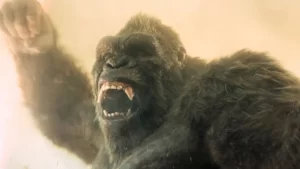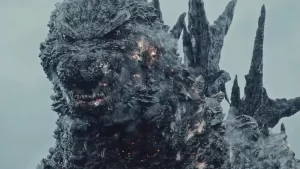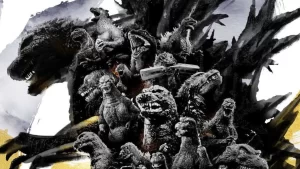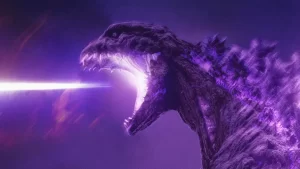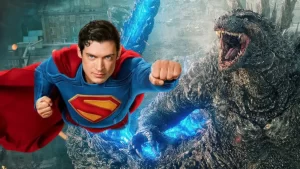Yep, Another Giant Monster Movie
A Film Review of Godzilla (2014)
By Lawrence Napoli
[[wysiwyg_imageupload:15442:]]
There’s only so much you can do with a monster movie when your monsters 1) don’t speak, 2) aren’t the real focus of the story or 3) behave exactly the same as they have in every giant monster attack film seen by audiences all over the world since the birth of this genre. That still won’t stop Hollywood from trying as everyone’s favorite beast from the east, Godzilla, rears his stubby snout and portly belly [sign that lizard up for some Jenny Craig!] in a disaster film that tries to breathe some freshly radiated energy into the creature’s origin and purpose for existing. I don’t mean to lay a MUTO egg down the throats of everyone that helped make this film (because there is artistry in every completed film thanks to its collaborative nature; regardless of its end quality), but I struggled to find any entertainment value in this film. In recent history the audience has seen more visually imposing disasters, better looking monsters, more satisfying action involving said monsters and most importantly, more interesting human stories that always become the plot engines for these types of spectacles.
Novice screenwriter Max Borenstein created this screenplay for Godzilla based on a story conceived by one of the “brains” behind The Expendables franchise, Dave Callahan. In it, the audience is treated to a retro-reboot of the King of Beasts’ most iconic films of the 60s and 70s which thankfully ignores the atomic bomb that was Roland Emmerich’s interpretation in 1998 starring Matthew Broderick and sees Gojira return to his heroic roots. At one point in this film’s first act, an idea is introduced suggesting that the Big G is a force of nature meant to restore balance to the planet. That would have been a neat idea to frame an entire giant-monster-attack film around. Too bad it was conveniently pulled out of thin air by Dr. Serizawa (the “lead” MUTO scientist?) and shelved immediately because this moment’s only purpose was to get the audience thinking the giant lizard might be good. These are the kinds of plot twists that make a story more interesting because (traditionally) they are well setup for the audience to discover with onscreen action or investigative dialogue. Unfortunately, Godzilla’s story is not presented with any methodology outside of left-field, coincidental moments of clarity where the divine intervention of lazy writing empowers every character to move the plot ahead without any particular connection with or loyalty to any previous scene.
The other problem I have with this story is the fact that people go to see these movies for Godzilla, Rodan, Mothra, etc., yet they aren’t the main characters in their own tales due to the understood communication deficiencies of these larger than life beings. Thus, the story must focus on the screaming masses of human beings that foolishly try to control the situation while they avoid being stepped on. In this regard, Godzilla is likened to Michael Bay’s Transformers in that the movie should be renamed: Stupid Humans and Their Godzilla Pet. That’s not to say the monsters couldn’t accomplish this task, but that would have required shutting up the entire cast for chunks of screen time to allow the Massive Unidentified Terrestrial Organisms to pantomime some plot and formulaic filmmaking will have none of that. Perhaps the strategy of leaning on the monsters more wasn’t even considered, but it would have been a welcome novelty considering every aspect of the human part of this story is as annoying as it is recurring. Scientists that are experts in their fields have no clue what’s going on, military people want to blow everything up, soldiers want to protect their families, blah, blah, blah. Zero of these human subplots have any emotional weight. They feel tacked on, with minimalist dialogue and performed with the gravitas of a high school musical save for Bryan Cranston’s contributions (but we’ll revisit his situation later).
The visual spectacle of giant monsters destroying locations of the world that aren’t named New York City, Los Angeles and Washington D.C. looks good enough, but certainly nothing different from the city wide destruction we see every day on the national news as a result of war and natural disasters. Part of the problem is that the audience doesn’t actually see the giant monsters actively ripping skyscrapers to shreds until the climactic battle late in the film. What we do see is a lot of aftermath shots of urban areas that look like bombs were dropped all over, but they are static and completely devoid of danger. It makes you wonder where all the money from a very healthy $160 million dollar budget went, and I presume it went to animating Godzilla himself who looks great (especially when he “charges up”), but he’s the only exceptional visual effect at work for the duration. I’d also like to restate how the climactic battle was a real treat to watch, but it left me wanting more and wondering why I didn’t get it this whole time. I suppose long time special effect engineer turn director Gareth Edwards felt that a couple of really good looking moments with monsters is enough to satisfy an audience so long as it’s supplemented with some average looking stunt work featuring people being crushed, people falling down and people otherwise at the complete mercy of these forces of nature.
As this review closes out, I will briefly comment on the “acting” that was apparently at work in Godzilla for which the entire cast can be described as looking like the “deer in the headlights” at all times. Quicksilver (Aaron Taylor-Johnson) and Scarlet Witch (Elizabeth Olsen) seem to be a package deal as they play husband and wife Ford and Elle Brody in this film as a family displaced by a mega monster grudge match. I guess I can’t blame them for a severe lack of romantic chemistry seeing how they have two scenes together, but I can blame the casting directors (four of them, if you can believe it) for recruiting an actor meant to play a tough soldier leading man who still sounds like he’s 13 years old. I suppose casting someone from the Olsen bloodline was fine for Godzilla because her role impacts no other character, no additional subplot and is completely irrelevant. David Strathairn and Juliet Binoche are here strictly to pick up their paychecks. Ken Watanabe further demonstrates his exponential mastery of the English language with his five lines. As for Bryan Cranston, the most respectable actor in this entire cast, I only have two things to say to the reader: Deep Blue Sea (1999) and Samuel L. Jackson. You do the math.
The fact is that Godzilla is a license that’s going to keep coming back to the big screen because of a ready-made fan base and global recognition, but whether these films are ultimately good is strictly in the eyes of the beholder. However, I gained increased appreciation for the 60s and 70s films after watching this most recent installment and especially for the ones that showed cheesy dialogue between Mothra and Godzilla regarding the king lizard’s hesitance to help human beings because they always open fire on him whenever he shows up to help. That’s Academy Award winning material when compared to this film and although the campy films of the past don’t have all the bells, whistles and big names of 2014’s Godzilla, they have a hell of a lot more heart. This film is a pass. It’s too bad this movie will still be occupying IMAX theatres into next week because I’d rather spend a few more bucks to watch Days of Future Past on the largest screen possible.


